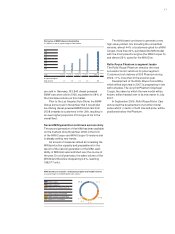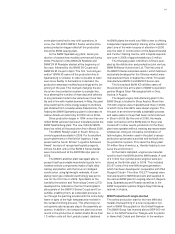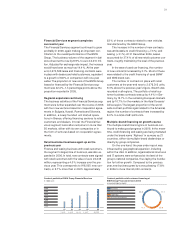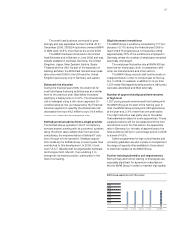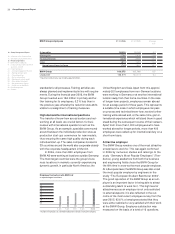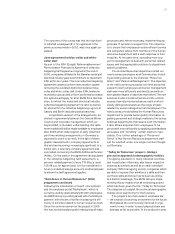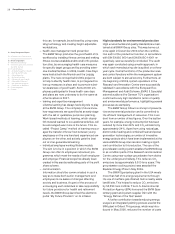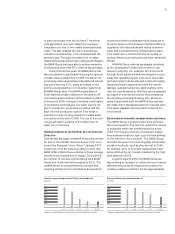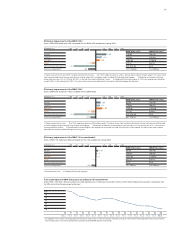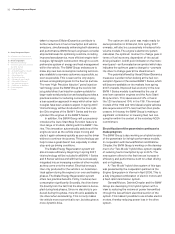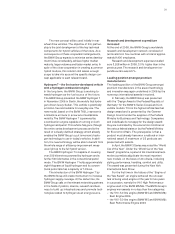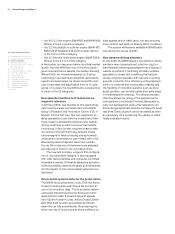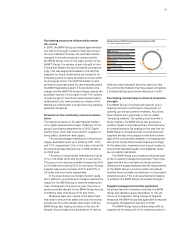BMW 2006 Annual Report Download - page 28
Download and view the complete annual report
Please find page 28 of the 2006 BMW annual report below. You can navigate through the pages in the report by either clicking on the pages listed below, or by using the keyword search tool below to find specific information within the annual report.27
The outcome of the survey was that the high level
of satisfied employees (91.1%) registered in the
previous survey made in 2002, was once again sur-
passed.
Joint agreement for blue-collar and white-
collar staff
As part of the ERA (Entgelt Rahmenabkommen/
Remuneration Framework Agreement) collective
bargaining tariff agreement signed at the end of
2005, companies affiliated to the Bavarian metal and
electrical industry gave a commitment to implement
ERA within four years.This new collective
bargaining
agreement creates a uniform remuneration system,
removing the outdated distinction between blue-
collar and white-collar staff. Under ERA, twelve re-
muneration groups and uniform performance evalua-
tion systems
will apply for all of BMW AG’s German
sites, for which the metal and electrical industry
collective
bargaining agreement is valid, as well as
for sites within the collective bargaining regions of
Saxony and Berlin (excluding sales branches).
A significant element of the arrangements, an-
chored in agreements between the General Works
Council and corporate management which go
beyond ERA, is the basic understanding that
retire-
ment models will still be made available to employees
after 2009 (when state support of early retirement
part-time working arrangements in Germany is
expected to come to an end). In the light of demo-
graphic developments, company agreements of
this kind are becoming increasingly significant. In a
similar vein, a voluntary company agreement was
concluded concerning the BMW Additional Pension
(AVWL). On the basis of this agreement (as stipulated
in the collective bargaining tariff agreement), a
pension-related payment of euro 319.08 p.a. (euro
159.48 p.a. for apprentices) is to be transferred in
future to individual savings accounts for all employees
to whom the tariff agreement applies.
"Excellence in Human Resources" (EHR)
programme continued
Following the introduction of new IT core systems
and the employee portal “MyNetwork”, which is
currently used by approximately 80,000 employees,
the BMW Group is pushing ahead with the EHR pro-
gramme, with the aim of further increasing the effi-
ciency of activities related to human resources work.
Since the commencement of the project in 2005,
this has involved analysing and redesigning all major
processes and, where necessary, implementing ap-
propriate IT systems to support this. The objective
is to ensure that employees receive efficient service
and competent advice from members of the human
resources department and a swift response to their
enquiries. At the same time, it provides more sup-
port to management to deal with personnel-related
issues and find appropriate solutions to department-
specific problems.
The Human Resources department rolled out
new business processes at all German sites, includ-
ing providing access to the channels “Personnel
Direct” and “Personnel Management”. The objective
of the new business processes is to lend personnel
support to both employees and senior management
staff even more efficiently and directly and with an
even greater degree of expertise than before.The new
business model is constructed around the uniform
access channels mentioned above, each of which
clearly distinguishes between the range of tasks
relevant for senior management and employees.The
new business model allows the Human Resources
department to provide better quality information
re-
garding personnel and strategic matters to the various
business departments that require such information.
It also allows enquiries from employees to be
processed more efficiently by applying
standardised
processes and “bundling” certain topics for spe-
cialists. One further advantage of “Personnel
Direct” is that Human Resources department
staff
can be reached under one single number
through-
out Germany.
“Today for Tomorrow” project – taking a
pro-active approach to demographic realities
The ageing population in many industrial countries,
and in particular in Germany, also has an impact on
business as a whole as well as on each individual
company. Within an ageing society, companies which
are able to improve their workforce’s skills and then
put those skills and know-how to best use will be
at a distinct advantage. The BMW Group is imple-
menting this by means of an all-embracing project
which has been given the title “Today for Tomorrow”.
The objective is to exploit the continual demographic
change as an opportunity for the business.
The project’s five main areas of emphasis are:
–
the creation of a working environment for the future
Workplaces are continuously improved in ergo-
nomic terms, in order to avoid physical strain and
damage as far as possible. In the production area,


